Last year, the marketing team at Ahrefs published over 150 articles and 30 videos. While achieving those numbers is challenging for a lean marketing team, they did it without compromising on quality. How? By following a content development process.
In this guide, you’ll learn what content development is, why it’s important, and how to develop a robust content development process in seven steps:
- What is content development?
- Importance of a content development process
- Seven steps to a robust content development process
But before diving into the steps, let’s first define what content development is and learn about its importance.
Content development is the combination of the different steps involved in the entire lifecycle of a content piece—right from its conception to distribution. It involves steps like audience research, brainstorming, planning, editing, and more.
While you may confuse content development with content strategy, both are different. The latter focuses on the overall vision and plan for your content.
However, a robust content development process is a critical part of any content strategy.
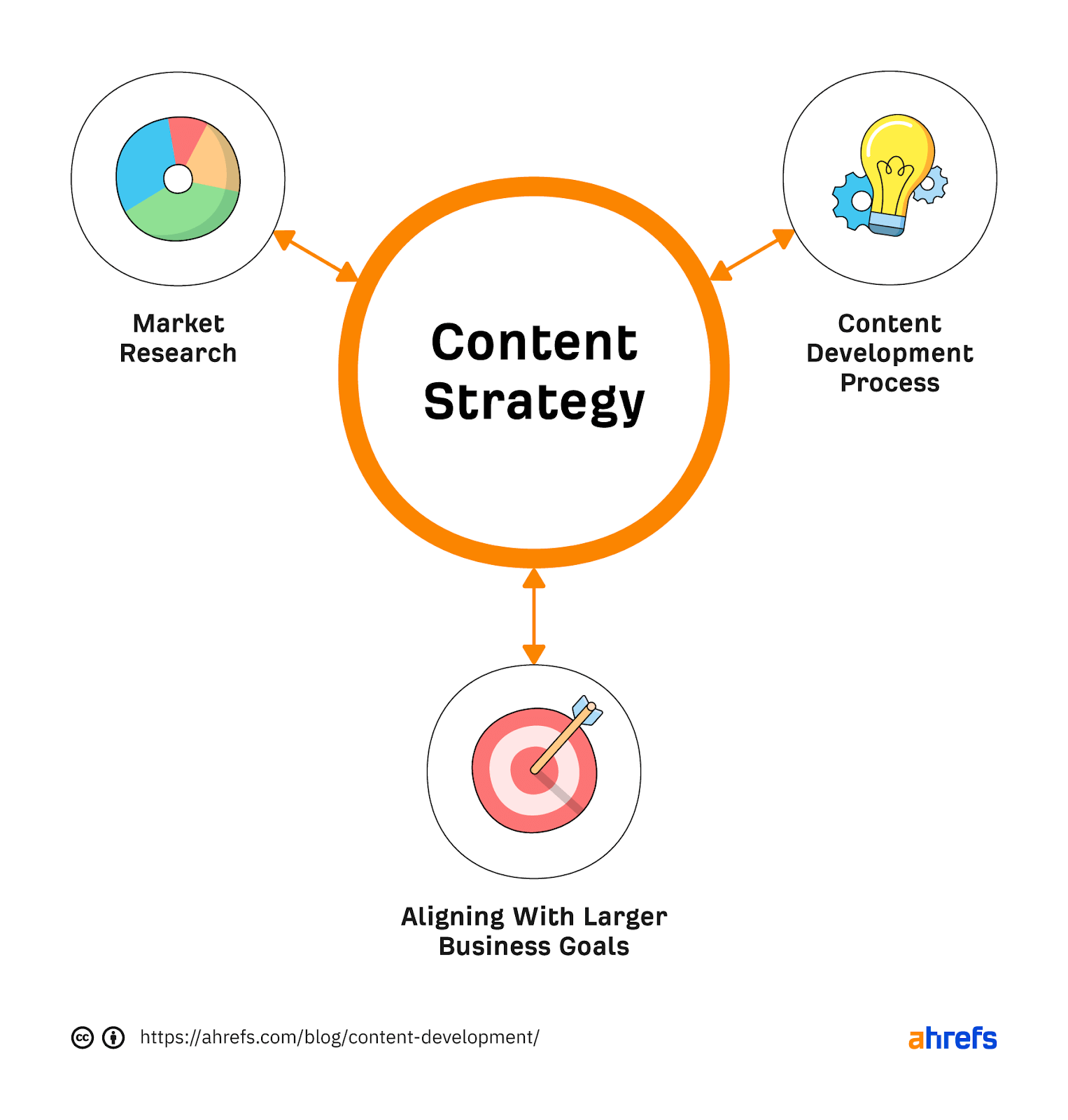
I understand that creating and implementing a content development process may feel daunting. So here are three main benefits of why having a content development process is a necessity for anyone serious about content marketing:
- Scale content faster – Knowing the exact time and effort required to create different content pieces allows you to allocate resources and budget faster.
- Align content with business goals – A content development process ensures each content piece is created with the overall content and business goals in mind.
- Increase efficiency – Having a set process minimizes the effort required at each stage in the development process.
While there’s no one-size-fits-all model, I’ve narrowed the process down to seven important steps that anyone can build upon to create a content development process for themselves. Let’s get into it.
1. Understanding your market
It’s simple. To create content that truly resonates with your target audience, you need to know them well. There’s no other way around it.
If you’ve done any market research before, you should already have a lot of information about your target customers. Here are a few ways you can use it further to generate content ideas:
Analyzing your competitors’ top content
By analyzing the top content of your competitors, you can quickly understand what type of content and topics your target audience is most interested in reading about.
You can use Ahrefs’ Site Explorer to find the top pages. Enter a competitor’s blog URL and go to the Top pages report:
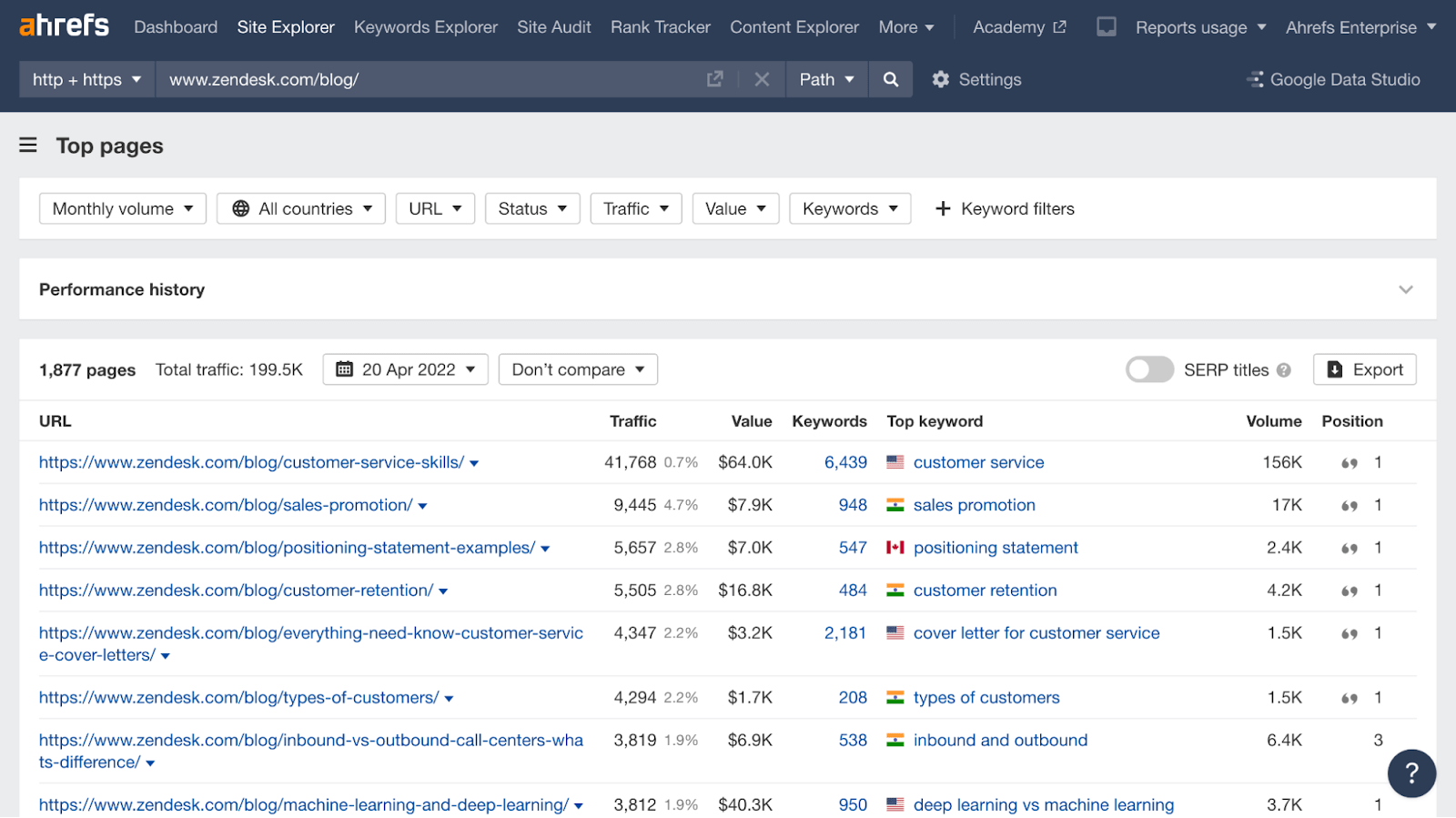
What you now see are the best-performing pages by organic traffic.
Talking to customers
Before working on any content, talk to your existing or potential customers to understand their challenges and how they think your product can add value to their lives.
Nothing beats the insights gained by talking to customers.
For example, at Ahrefs, a lot of our customers are part of a closed Facebook community. Just by analyzing the conversations, the questions being asked, and conducting polls, we get a good understanding of what topics we can write about.
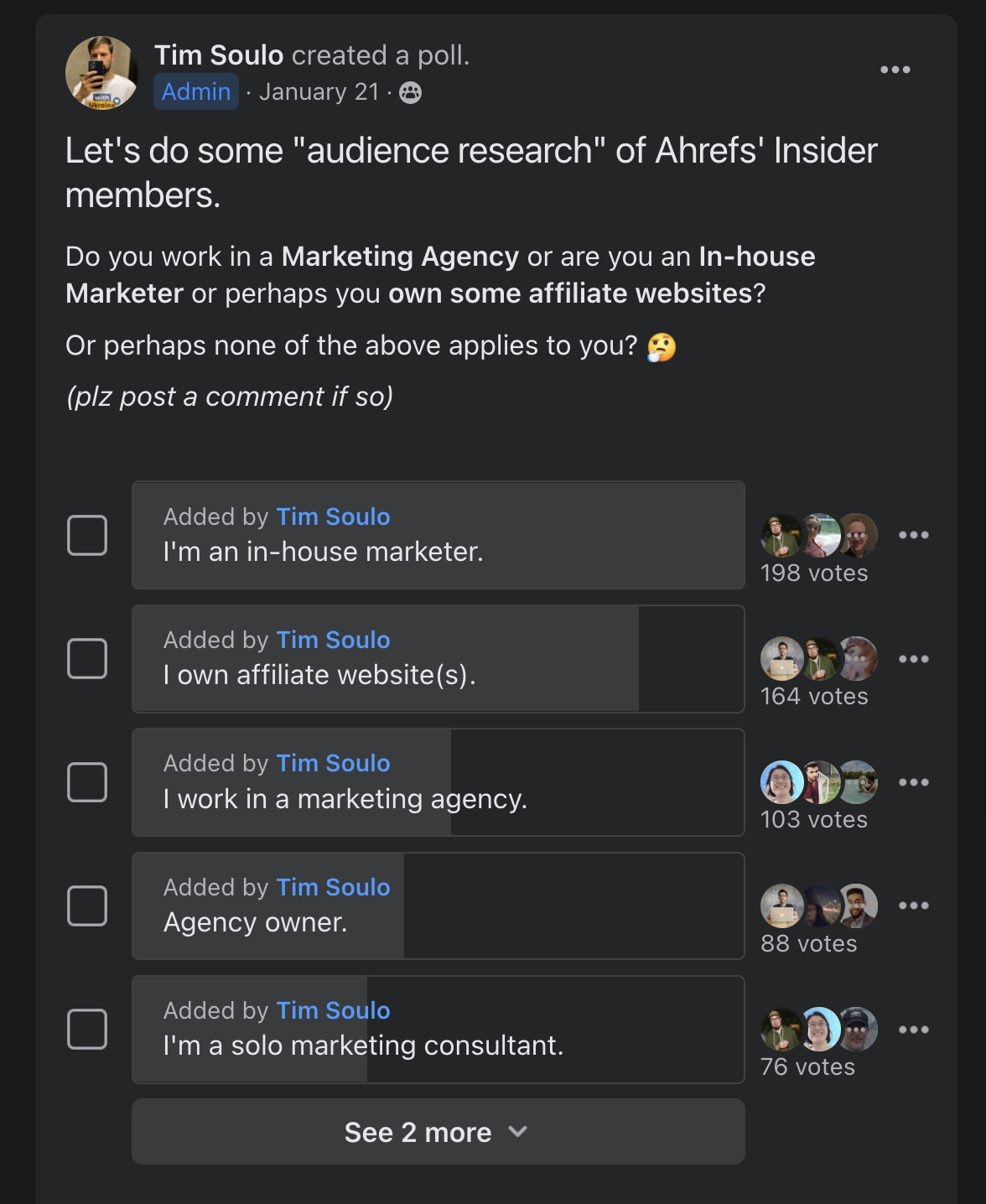
Using audience intelligence tools
By leveraging audience intelligence tools like SparkToro, you can easily find the social accounts your target audience members follow, the websites they visit, the hashtags they use, and more.
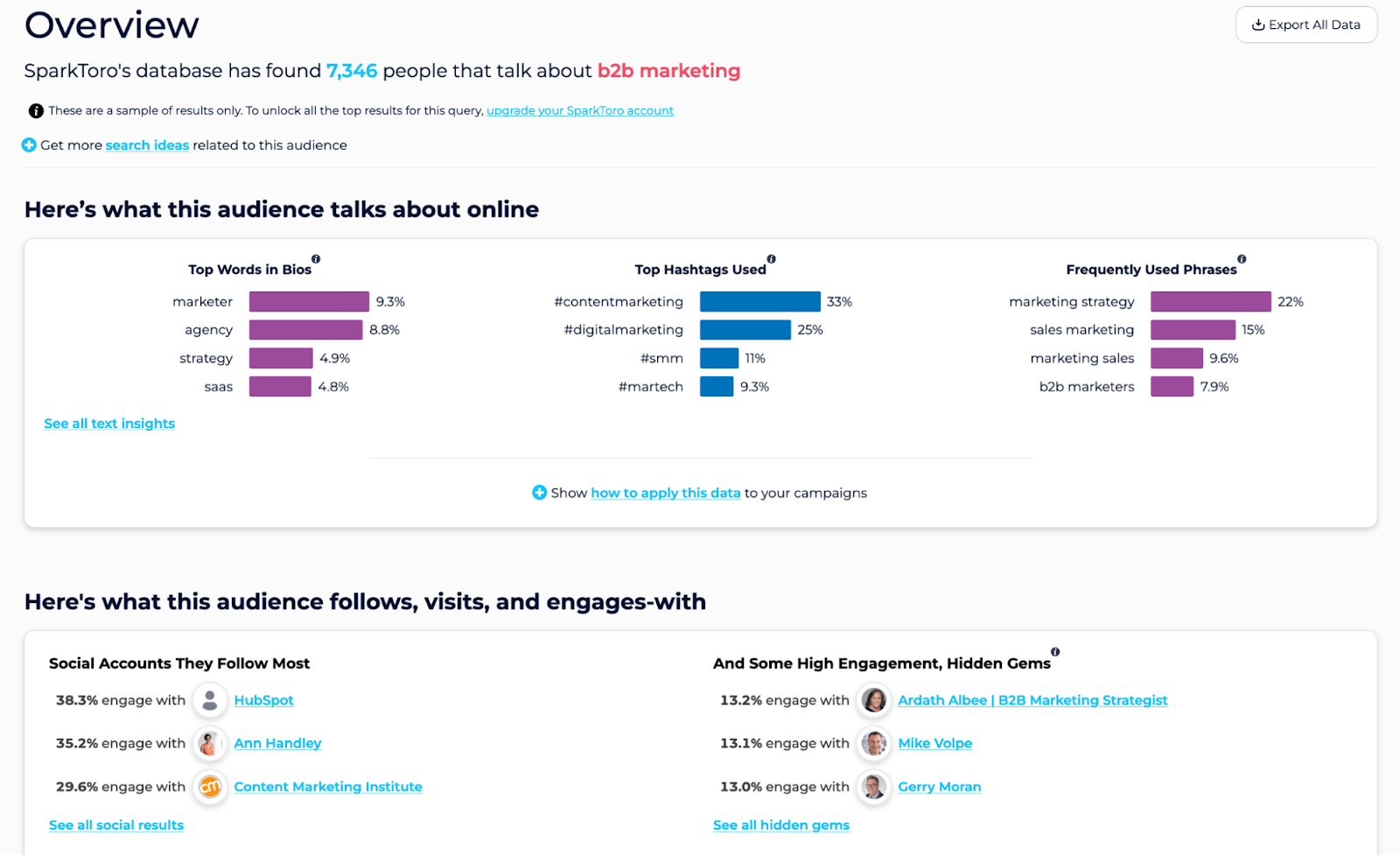
You can easily use this information to generate new content ideas, find distribution channels, and more.
2. Be clear on the purpose of your content
Every content piece should have a clear purpose. Whether it’s driving organic traffic, building thought leadership, or increasing product usage.
Setting an objective helps you to track the right metrics that define the success of the content. It’s impossible to evaluate the content otherwise.
For example, for this post, one of our goals is to rank in the top three positions for the keyword “content development.” Thus, we’ll be tracking this keyword using Ahrefs’ Rank Tracker.
Here’s an excerpt from another Ahrefs article outline that defines the angle, goal, and unique selling point. This helps us write unique content with the objective in mind.

3. Content planning
You may have a lot of content ideas to work on. But you should start off with only a few. Here are metrics you should take into account for prioritization:
- Business potential
- Traffic Potential (TP)
- Keyword Difficulty (KD)
Business potential
To attract the right audience and drive engagement, you need to focus on writing content that highlights your product as a solution. For business potential, here’s the scale the Ahrefs team uses:
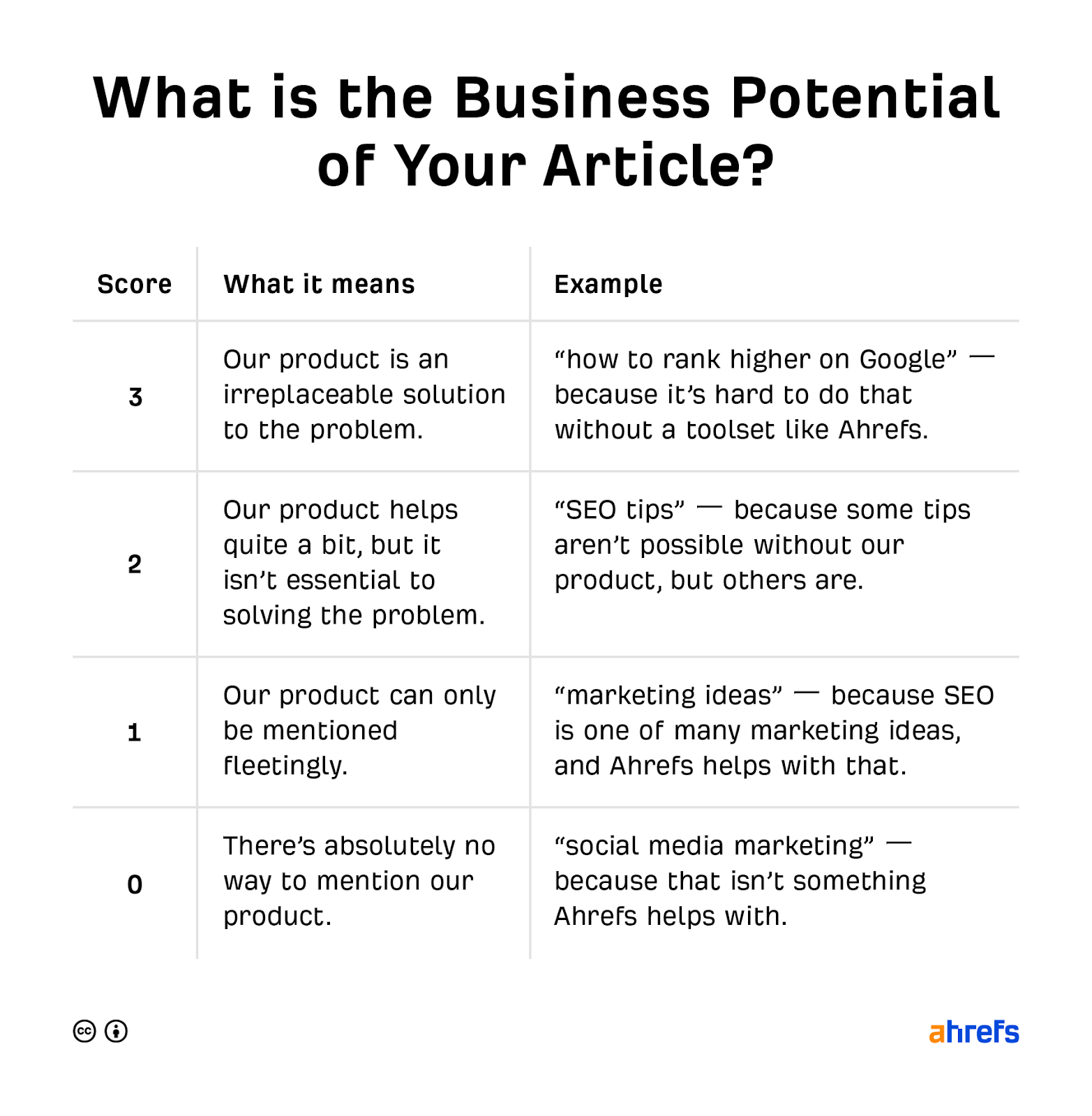
Traffic Potential
Just targeting a keyword with high search volume is not enough. You need to look at the overall TP because one piece of content can rank for thousands of different keywords. For example, the keyword “how to water a snake plant” has a keyword volume of 700, but its TP is almost five times the search volume (at 3,100).

On the other hand, some keywords may have high search volumes, but the TP can be comparatively low.
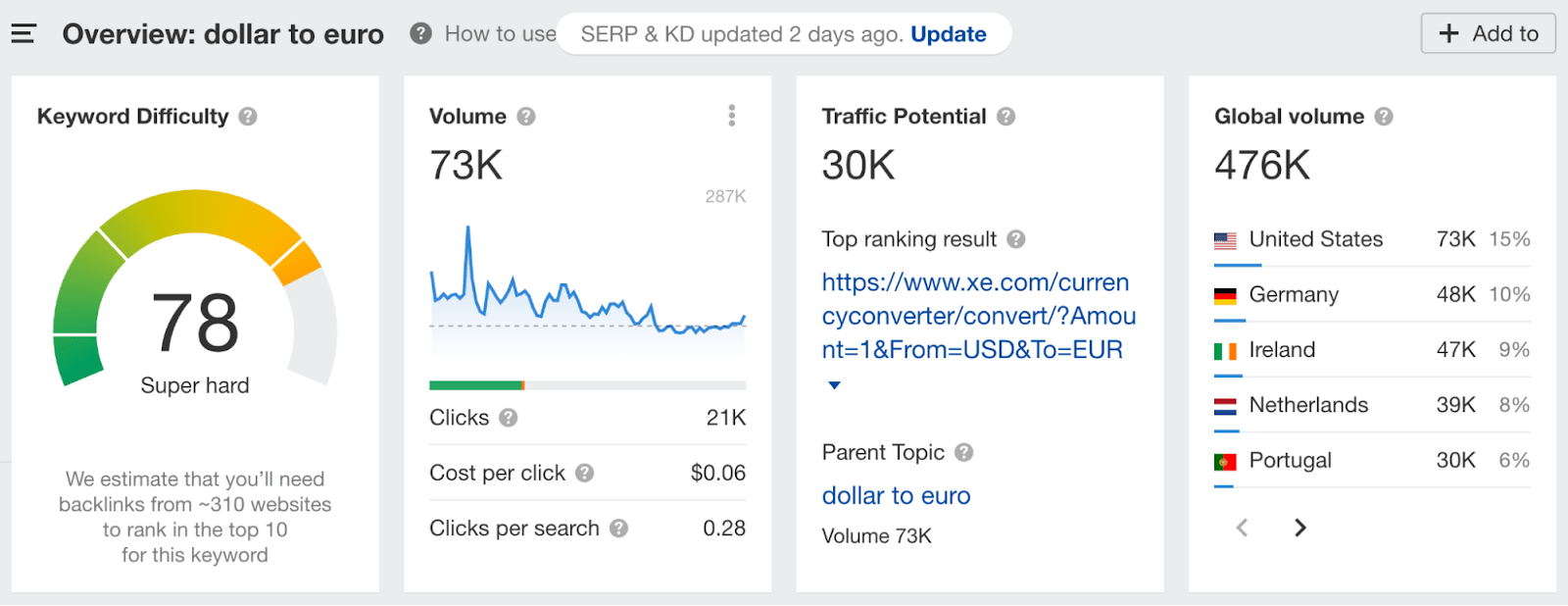
Keyword Difficulty
KD gives an estimation of how hard it is to rank a keyword in the top 10 SERP positions on a 100-point scale. Along with difficulty, Ahrefs also estimates the number of backlinks you’ll need to rank for a particular keyword.

The lower the KD score, the easier it should be for you to rank high for the keyword rather quickly.
But generally, it’s best practice to target all the relevant keywords that you hope to rank for in the future—even if the KD is high. This will help you understand where you stand and constantly improve rankings as you update the content or build backlinks to it.
Matching the search intent
Creating content that aligns with search intent is incredibly important.
Search intent is the “why” behind a particular search query. It’s related to the content type, content format, and content angle.
Matching search intent is critical because Google aims to provide users with the most relevant result for each query.
You can understand search intent by going through the top-ranking results for a particular keyword. It’s best if you do it right in the SERP overview section inside Ahrefs’ Keywords Explorer because you can see all the relevant metrics there as well.
For example, the intent of the keyword “content marketing examples” is list posts:

Here, the intent for the keyword “install windows 11” is predominantly tutorial videos:
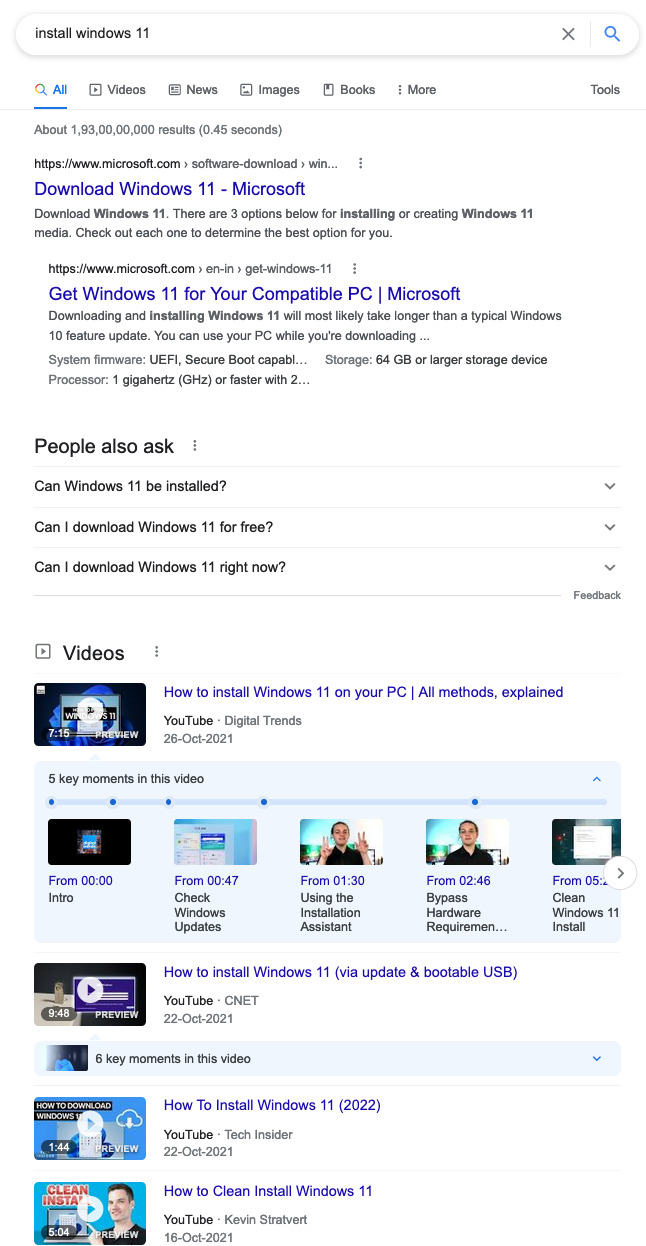
Creating a content calendar
I cannot emphasize enough the importance of planning ahead and tracking content creation. And that’s where a content calendar comes in.
A content calendar gives you a bird’s-eye view of content planning and which content pieces are on track, delayed, and more.
At Ahrefs, the content is typically planned one to two months ahead. But you can choose to plan it according to what suits you best.
If you’re looking for platforms to create a content calendar on, try Notion, Trello, or Airtable. These are the most popular platforms content teams use.
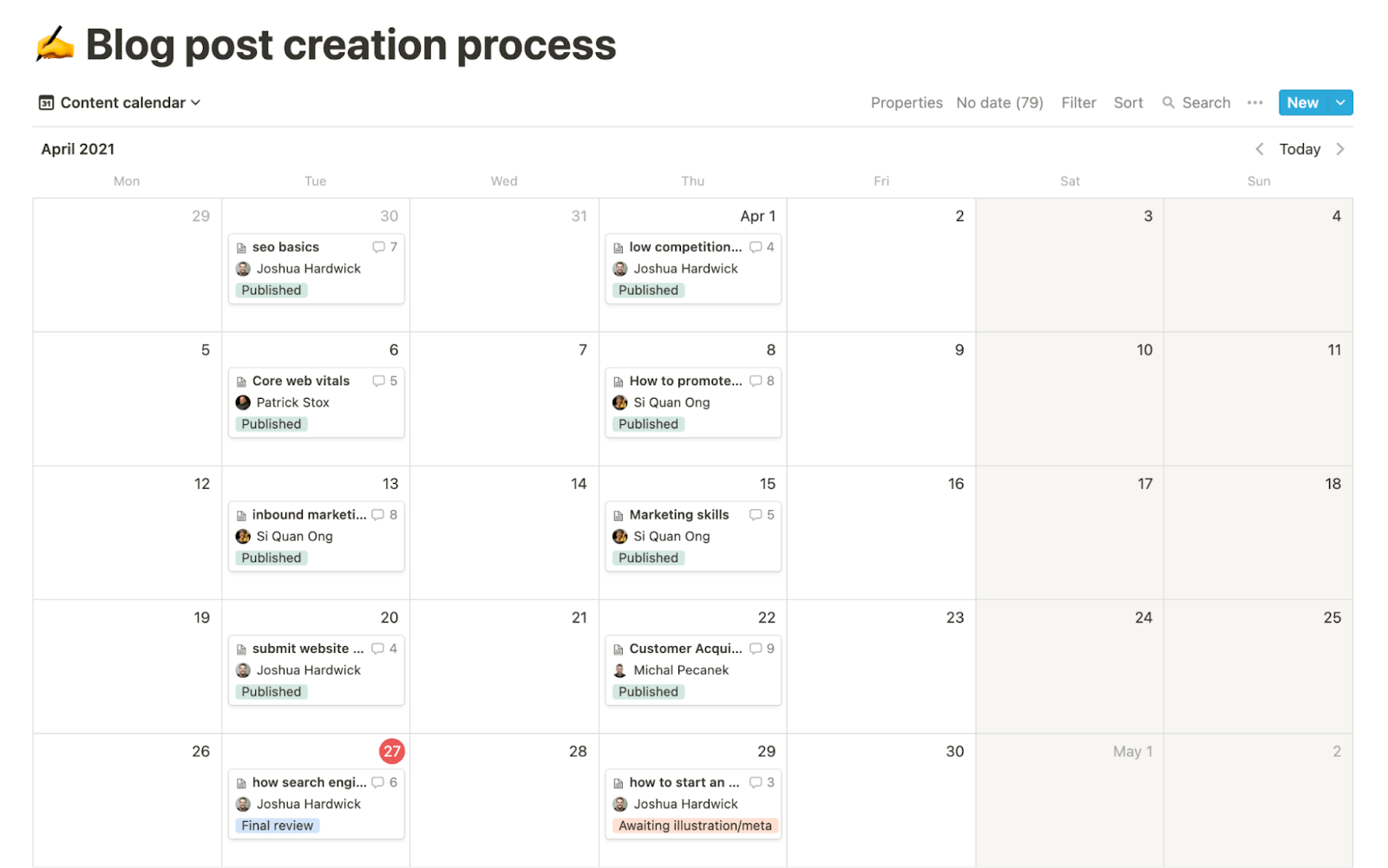
4. Content creation
Everyone approaches content creation differently. There’s no set process for this. However, there are definitely a few tactics you can implement to streamline the process.
Create a content style guide
A content style guide is a document that illustrates standards for content on a particular website. This helps in enforcing style rules for maintaining consistency and improving communication.
This is especially useful if you outsource your content creation to freelancers and agencies. For example, before writing this article, the Ahrefs team shared with me (as an external contributor) the:
- Contributor Guidelines (this explains the different steps for writing).
- Blog Writing Guideline/SOPs (for creating an outline, formatting, etc.).
Recommended reading: How to Create a Content Style Guide
Templates
You don’t need to create every content piece from scratch. Most of the ones you create often fall into a certain type, e.g., list post, video, guide, etc.
For each type, you can create a template to use as the foundation. Then start working on the post. Here are a few blog post templates for your reference.
SOPs
SOPs (standard operating procedures) are documents explaining how to do specific tasks within your organization for content creation. For example, you can create an SOP for publishing a video on YouTube or writing a blog headline.
Creating SOPs greatly increases the efficiency within the team and is also useful for new employees. It’s also great if you work with many external agencies and freelancers for content creation.
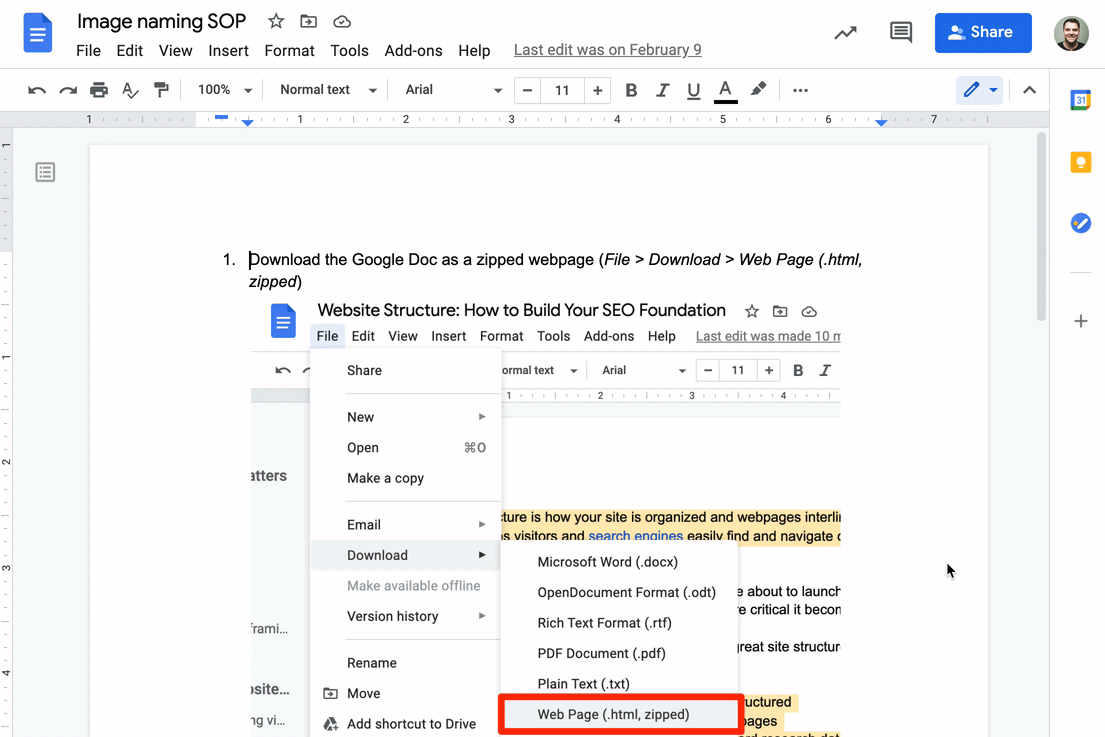
In a recent talk on “scaling content,” our head of content, Joshua Hardwick, spoke about the three S’s of content creation:
- Systemize – This is setting a defined process for publishing content from the ideation stage.
- Standardize – Creating SOPs for different tasks. In Joshua’s own words, “You need SOPs. They are life.”
- Streamline – You should figure out a way to do everything better.
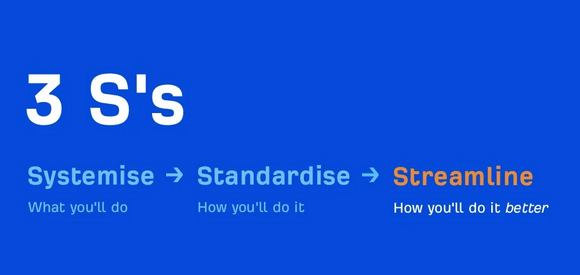
Feel free to go through his slides of the talk here.
5. Get feedback on your content
To ensure every piece of published content is free of errors and aligns with your content guidelines, getting external feedback and content editing are necessary.
As content creators, it can be difficult to spot mistakes in our own content. And that’s where someone else’s feedback is critical. Your content needs to be subjected to the scrutiny of other experts.
Depending on the frequency of the content being produced, you can hire content editors, outsource editing, or use peer editing.
At Ahrefs, every article is scrutinized by a second person on the team. They point out things like logical loopholes, choppy flow, unclear points, poorly phrased sentences, and so on. They’re also featured as contributors at the end of the article alongside the author.

In addition to this, at Ahrefs, there’s a dedicated content editor whose responsibility is to proofread every article, align it with the house style, upload it to WordPress, and then update internal links.
You can also share content with people in different functions (e.g., sales, products) or industry leaders and connections to get an outside perspective. Remember, reviewers don’t have to be limited to people within the marketing or content teams.
6. Distribution
To ensure you meet your desired content goals, just creating great content is not enough. You need to have a content distribution strategy in place.
Again, there is no one-size-fits-all model. How you tweak your strategy depends on the objective of a content piece.
For example, if you’ve created a data-driven study with the objective to get links from publications like Forbes and Entrepreneur, your content needs to be seen by journalists or contributors—whether it’s via a cold email, social media platforms like Twitter and LinkedIn, or paid advertisements.
The distribution channels can be divided into owned, earned, and paid channels.
Examples of owned channels:
- Website or blog
- Email list
- Your accounts on social media platforms
- YouTube
Examples of earned channels:
- Facebook groups and Slack communities
- Twitter mentions
- Forums
Examples of paid channels:
- Twitter Ads
- LinkedIn Ads
- Sponsorships
- Native advertising via platforms like Outbrain
There are definitely more ways to distribute your content, as these are just a few well-known examples. You don’t need to limit your distribution to these channels. For example, you can leverage email outreach and reach out to influencers in your industry who may be interested in sharing your content.
Content repurposing
An underrated tactic to get more from your content distribution efforts is by focusing on content repurposing.
Content repurposing is the process of taking a piece of content and turning it into different formats.
By repurposing content, you instantly unlock different distribution channels and audiences to whom you can promote your content. And the best part is that because the content is already created, you don’t need to put in a lot of effort to repurpose it into a different format.
The only roadmap you’ll need to learn SEO👇@JoshuaCHardwick breaks down each component: pic.twitter.com/Rb3LxNIY3p
— Ahrefs (@ahrefs) April 13, 2022
For example, if you repurpose a blog article into a video, you can share it on video-sharing platforms like YouTube or TikTok. An often-used tactic that Ahrefs has leveraged on YouTube is to repurpose popular blog articles as YouTube videos, and it has proven to be effective.
7. Monitoring results
The only way to understand whether your content is meeting the set goals is by monitoring it.
For example, for monitoring website traffic, you can use Ahrefs’ Web Analytics, a simple, privacy-friendly alternative to Google Analytics. Similarly, if your objective is to drive organic traffic, then you should use Rank Tracker to monitor keyword rankings, traffic, and search visibility.
Here’s how you can get started:
- Open Rank Tracker and add the keywords:
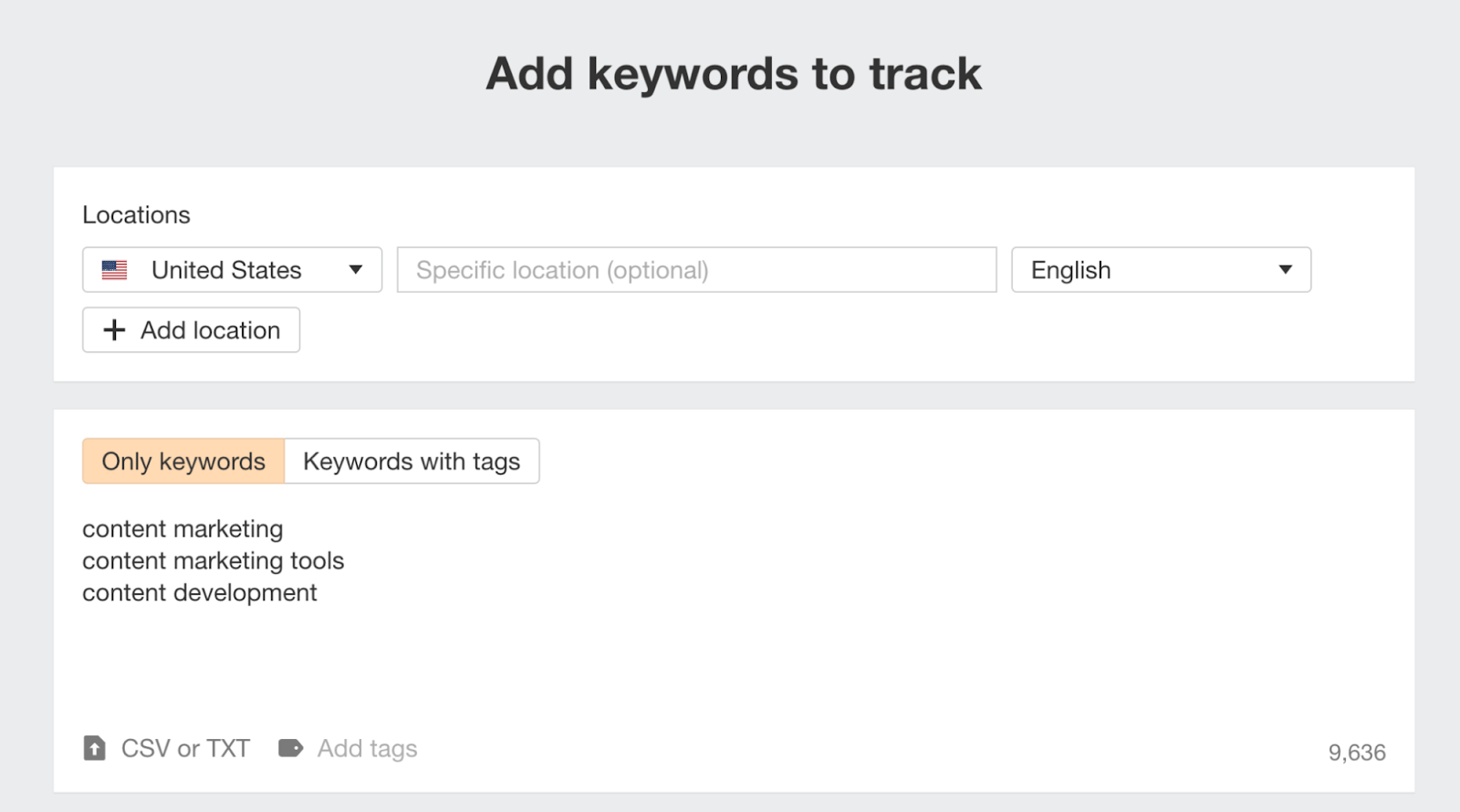
- Next, specify the location. You can choose one or multiple locations.
- Finally, you just need to click on “Add keywords” to submit your request.
- That’s it. Now you’ll be able to track your keywords, as well as metrics like average position, traffic, position distribution, and more.

Final thoughts
There’s no doubt that creating and implementing a content development process greatly helps in creating and scaling content faster.
Depending on the type of content you produce, a few steps will be more critical than others. However, you shouldn’t skip any step, as each has its own importance.
Got questions? Ping me on Twitter.



